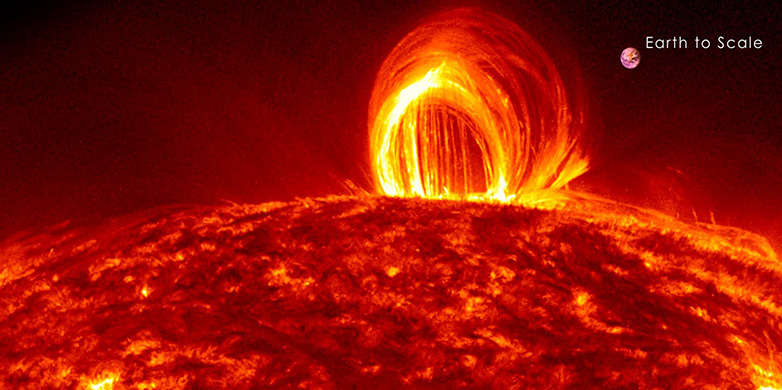Ancient solar particle storm quantified
D-USYS
An exceptional solar particle storm could make winter temperatures in Europe and Russia drop by three degrees Celsius and increase UV radiation significantly.
Scientists from six countries came to this conclusion after evaluating the strongest solar storm on record during the past 11.000 years: a storm in the year 774 AD. Solar particle storms are sporadic events, which by powerful eruptions hurl billions of tons (~1016 g) of hot hydrogen plasma to space. These can hit the Earth and may affect us in different ways. Thousands of solar particle storms were observed in the past decades, but only a few of them were rated as dangerous.
Were a storm comparable to the one in 774 AD to hit Earth today, we could abruptly lose the lion’s share of our satellite-borne telecommunication and navigation systems, and our national power grids might be down for months. However, what do such millennium storms mean for the Earth atmosphere and climate?
A solar particle storm from the past
An international team combining eleven groups from six countries (Australia, Finland, Italy, Japan, Russia, Switzerland), led by scientists from Switzerland and Finland, has studied these questions on a basis of the strongest known solar particle storm, which occurred probably in early Autumn of 774 AD, more than 1200 years ago.
No direct measurements are available for that event, of course. Using data of radioactive isotopes of beryllium (10Be) measured in Arctic and Antarctic ice cores and radioactive carbon (14C) in tree rings, the team has, for the first time, used the extreme solar particle storm of 774 AD as worst case scenario for the solar radiation hazard on the time scale of thousands of years. This sets a strong observational constraint on the risk evaluation of severe solar particle storms.
Impact on weather likely during subsequent year
By means of a reconstruction of the solar particle bombardment during this storm (based on the measurements of 10Be in ice cores and 14C in tree rings) and state-of-the art numerical models, the team has evaluated the possible atmospheric and climatic impact of such a severe event. They showed that the storm is able to significantly deplete the stratospheric ozone layer in the polar regions by 10-20%. Accordingly, the level of harmful UV radiation increases. For at least one year the ozone loss perturb the stratosphere-troposphere dynamical coupling, which can lead to a weather modulation in the Northern Hemisphere with regional changes in the continental winter temperature of +/-3°C.
Although these changes are short-term, they can lead to regional changes in vegetation, permafrost melting, avalanches or landslides. As the changes remain limited to one or two years, the authors for the first time could determine an upper bound of the risk potential of such storms.
Sukhodolov, T., I.G. Usoskin, E. Rozanov, E. Asvestari, W. Ball, M.A.J. Curran, H. Fischer, G. Kovaltsov, F. Miyake, T. Peter, C. Plummer, M. Severi, W. Schmutz, R. T, external pageAtmospheric impacts of the strongest known solar particle storm of 775 ADcall_made, Sci. Rep., 7, 45257 2017 (doi: 10.1038/srep45257)

